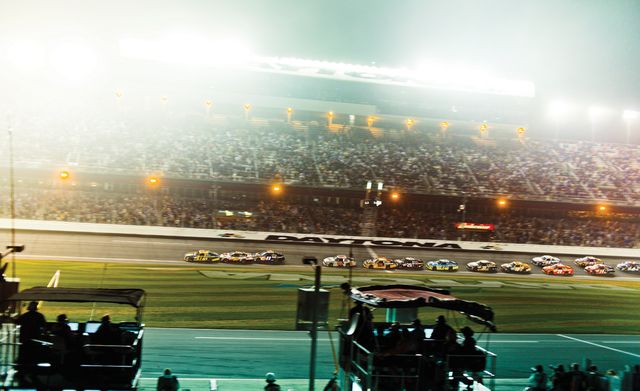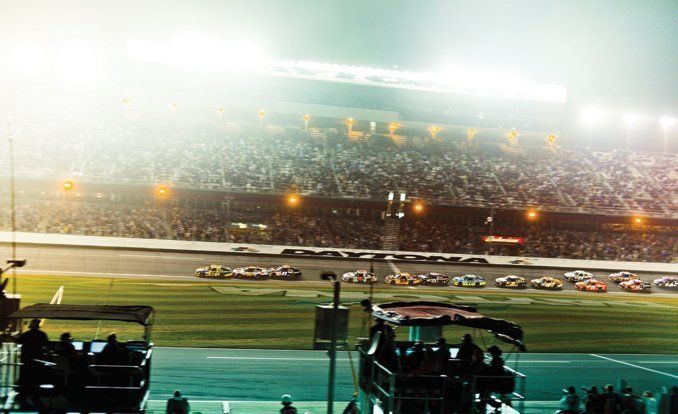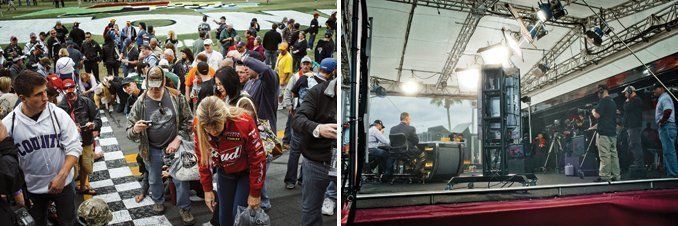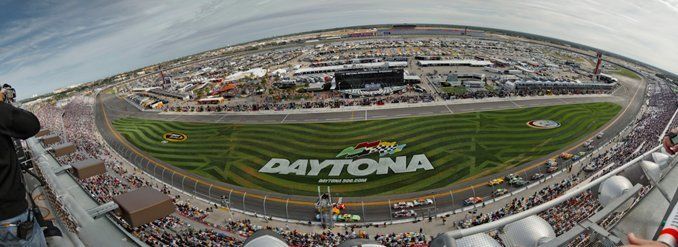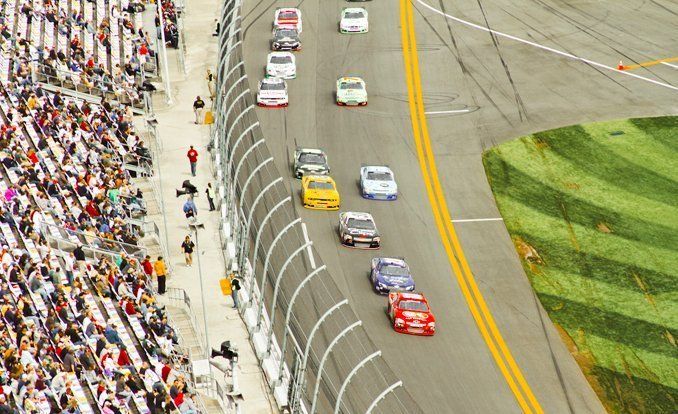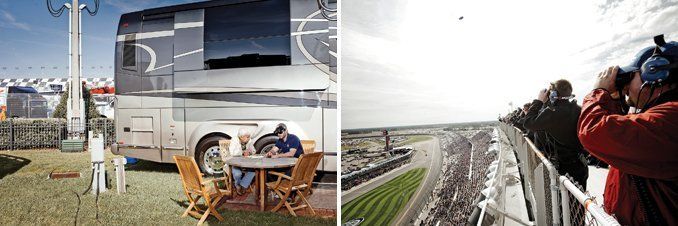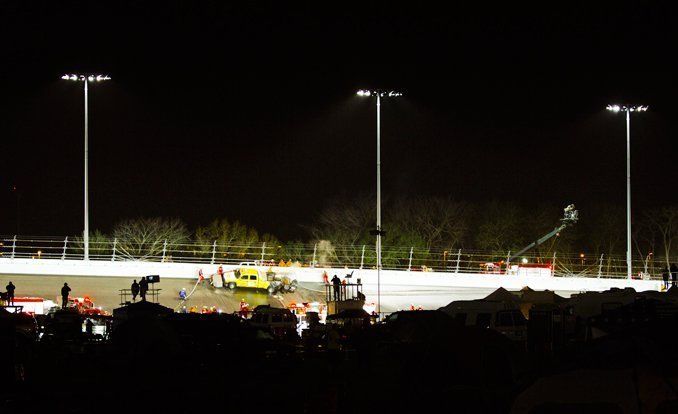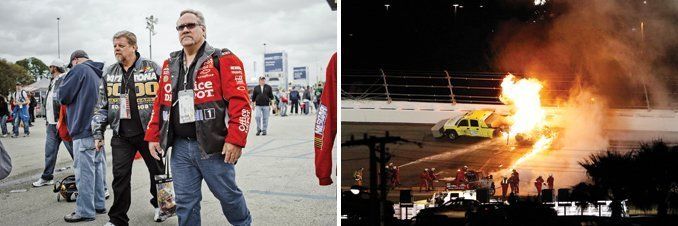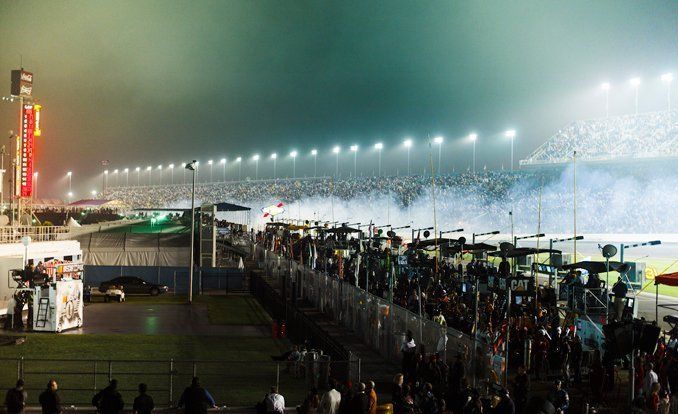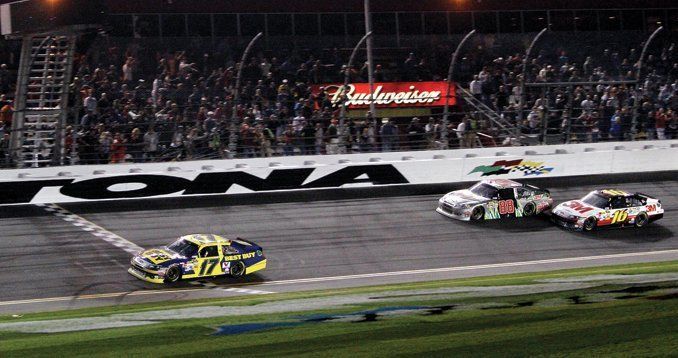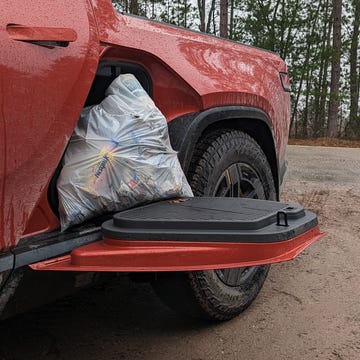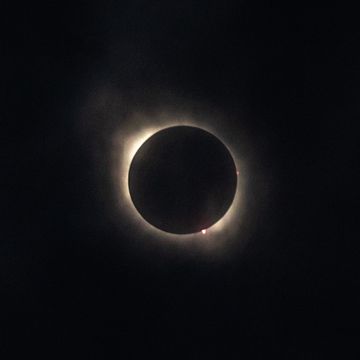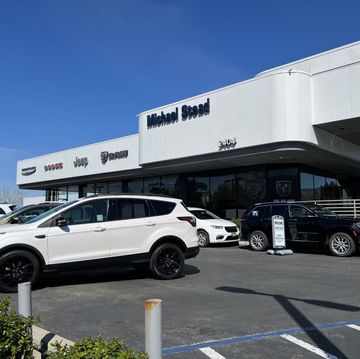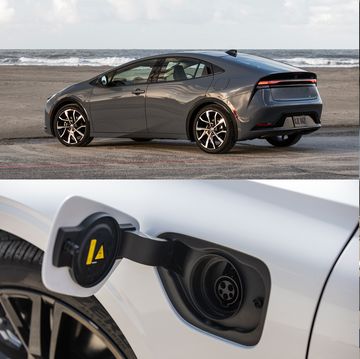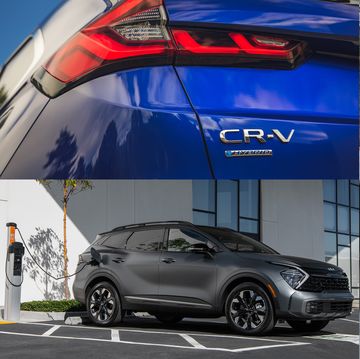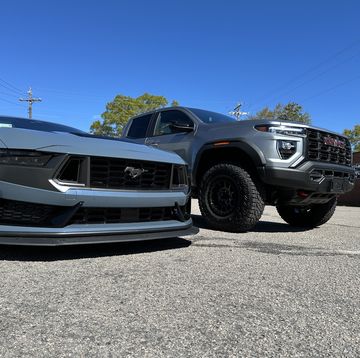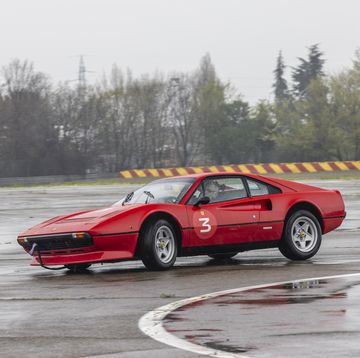"If this thing gets rained out before the end, we’re screwed, I mean, it’s a lot of money.”
The Fox PR man kneeling beside me was talking in a whisper inside a trailer filled with executives whose eyes were glued to the overhead monitors. It was five minutes after the long-delayed start of the Daytona 500, Monday, February 27, and the race was 30 hours behind schedule. For Fox, if the never-before-rained-out 500 now had to be put over again until the next day, the issue was not only lost ad revenue (the audience share for Tuesday daytime being considerably less than for “sports Sunday”) but the 500-mile race in Phoenix the next weekend. Phoenix is 2100 miles away. Fox would have to get its caravan of 29 trailers there in time for practice on Friday morning—which may have been no more, no less than the car owners’ problems in having to send their haulers back to home-base Charlotte for fresh race cars first—but it was a logistical nightmare any way you cut it. Mike Helton, NASCAR’s president, had called a meeting at 9 that morning to acknowledge that if they didn’t get through this evening and the rain didn’t quit by morning—as some weather reports indicated—the next available date was not until Easter Sunday. Screwed indeed.
Historically, sometimes people do, in fact, get lucky. Driver-turned-promoter Bill France got lucky. He came to Daytona Beach, Florida, in 1935, raced on the sand in the 1930s and early ’40s, and bought a piece of the town that already enjoyed a reputation as a speed-record-setting and stock-car-racing venue. In 1948, he founded the National Association for Stock Car Auto Racing. That enterprise quickly prospered—in large part because of Americans’ postwar love affair with their Fords, Chevys, Oldsmobiles, Hudsons, and Chryslers. The first races were run on the hard-packed sand; relying on local bond issues and endless glad-handing, France built the 2.5-mile Daytona International Speedway in 1959 and the even bigger 2.66-mile Talladega (Alabama) Speedway in 1969, two of the tracks that have come to embody the sport. Today, there are 12 Sprint Cup tracks in the France family portfolio and stock-car racing is America’s No. 2 sport, fractionally behind the NFL. The Sprint Cup, Nationwide, and Camping World Truck Series races are NASCAR’s premier events, and there are hundreds of regional races that serve as a feeder system for the national series. Week to week, from Valentine’s Day to Thanksgiving, all the major races are televised.
Scale is key. The purse for this year’s Daytona 500 was $19,142,601. The average worth of a top Cup team, according to Forbes, is about $143 million, while a seasonal sponsorship of a front-running car—think Tide, Budweiser, Home Depot—runs roughly $20 million. This is all but chump change compared with the annual revenue from licensed fan merchandise (caps, jackets, T-shirts), which NASCAR reports at $1 billion to $3 billion; that sum gets split between drivers, team owners, and the organizers.
But prize money and the profits from T-shirts go hand in hand with TV contracts, and it is TV coverage that keeps the sport whole: This year marks the sixth of NASCAR’s eight-year contract with the Fox network, which, together with ESPN/ABC and TNT, pays an average of $560 million a year in broadcast fees to NASCAR. But more important is that NASCAR attracts an average 6.5 million viewers to its races, making it one of the most-watched regular-season American sports.
“We’re in the entertainment business, no question about it,” says NASCAR president Helton. “Our model has always been free enterprise. We depend on the health and success of our teams, just as we value the loyalty of our fans.” Adds chairman and CEO of the Fox Sports Media Group, David Hill, “I’m proud of our relationship. The collaboration between Fox and NASCAR has produced exemplary television, and we’ve come a long, long way.”
NASCAR has been a family-held company since the beginning, and its partnership with Fox has had a lot to do with the Frances’ desire for “continuity of exposure.” The ’70s saw the emergence of cable that needed content. But by the late ’80s, when all the big NASCAR races were being televised, coverage was scattered. R.J. Reynolds, the organization’s chief sponsor at the time, had helped with inroads to the non-race fan, showing that a non-automotive company could use racing for advertising, and the Frances felt they had to take the rights back in order to negotiate a forward-looking and, indeed, modern package. CBS had a deal to cover Daytona; cable this and cable that had rights to cover Bristol and Charlotte or whatever. But there was no continuity or, for that matter, control.
“The Frances felt the sport would be better served by not parceling out the rights on a multi-network deal,” Helton explains.
Enter Fox and the huge profit-making exposure that continues to this day.
There has been grumbling that the mood of stock-car racing has changed, become more politically correct, but not by that much. Multimillion-dollar sponsors, it seems to be widely understood, don’t need to put their money on the kind of “bad asses” the sport used to attract—the legendary moonshiners, tough guys, and lotharios—even as they remain part of NASCAR’s outlaw mythology. NASCAR walks a fine line here. As was much publicized last year, legendary team owner Richard Childress, then 65, went after Kyle Busch, 26, for shoving Childress’s Camping World Truck driver Joey Coulter into the wall on the cool-down lap of the O’Reilly Auto Parts 250. Reportedly, the self-made Childress, himself an ex-driver, had approached Busch in the garage area and then proceeded to punch him in the face. The fight was broken up and insults were exchanged before Childress grabbed Busch and hit him again. NASCAR’s response from its new aluminum-and-glass headquarters across from Daytona’s main entrance was to slap Childress with a $150,000 fine.
But the need to put on a good show has also come to mean something bigger than NASCAR’s playing Emily Post. The new car regs put into effect this past year virtually determine how even the best drivers drive, or, for that matter, can’t. For 2012, the rear spoilers on Cup cars had to be lower and a valance added along the rear-fender and rear-bumper bottoms, along with smaller radiators that provide less engine-cooling capacity. Such changes were intended to discourage the one-on-one tandem racing of the year before, which NASCAR surveys show was turning off the fans. It didn’t matter that any number of drivers found that these modifications affected handling for the worse; the goal was better television—as the carnage of this year’s Bud Shootout plainly showed.
Racing as a Hemingwayesque test of courage? An expression of individualism that definitive tough guy A.J. Foyt or ex-moonshiner/ex-driver/Tom Wolfe–hero-par-excellence Junior Johnson could relate to? Apparently not. In NASCAR, TV is king.
In a sense, Darrell Waltrip, who has made one of the 21st century’s stellar career transitions—from Daytona 500 winner to Fox’s announcing team alongside the encyclopedic Mike Joy and Larry McReynolds—sees all this quite clearly. “What’s our job here at Fox?” he asks rhetorically. “Our job is to figure out how to draw the viewer in. It’s hard to put in the real sound of a race car going by at 200 mph. It’s hard to have the impact of a wreck, to convey just how hard these guys are hitting that wall. It almost looks mundane on TV. They smack the wall, and they roll off and they go on.”
Adds Fox producer Barry Landis, who heads the network’s small traveling army of 300 cameramen, researchers, sound and graphics people, announcers and reporters, and only God knows who all: “And Daytona is the telecast where we have by far the most viewers, a lot of whom are casual viewers. If the season première is lackluster, you’re going to lose 20 percent or more of your audience for the rest of the year.
“Those guys,” he goes on, referring to the Joy-Waltrip-McReynolds team and their lieutenants in the pits and infield, “did four straight hours with 21 interviews, plus a couple of features on Sunday. During the delay, we hung on to 7.7 million viewers. How did we do this? By being inventive. We knew that Joey Logano had bought a new dog. Okay, it’s a cute little thing—we do a piece on drivers and their pets. [Reporter] Matt Yokum has Logano in the pits, and our Steve Byrnes knows that Greg Biffle is a dog guy, so, ‘Hey, try to track down Biffle.’ ”
One issue the TV people haven’t dealt with is NASCAR’s increasingly stringent implementation of rules as something that has curtailed creativity and moved the sport further from its roots. Mark Martin, 53, one of the oldest and most successful drivers never to win the 500, recognizes the complexities. “When I started out, every driver I knew built his own car, and I won most of my races by making my car faster than the next guy’s. For my generation—the Rusty Wallaces and the Alan Kulwickis and the Dale Earnhardts—there were no engineers and there were no computers in NASCAR, okay? Does what’s happened make it not the same as the grass-roots racing? Yes. But I was lucky to race in the old days, and I also got to race when there was money in it.”
For Dale Earnhardt Jr., who’s decidedly not of Martin’s generation, the problem is even more pointed. “Every time they change the package, things about how the draft works change, and you have to go out and relearn things you like to use . . . A lot of the creativity we used to have, we don’t have anymore. We’re all in this little box.
“They want the fans to view the sport as an equal playing field. TV has made this sport, put us over the top—no argument about it. But there are days when I get frustrated at how much has changed. Just yesterday, there was like three or four camera guys, and for about 30 minutes at least one of them was filming me and the guys talking in the garage. I was thinking to myself, like in ’79, you could have free roam. ‘Hey, you want t’ go to the track with me?’ We’d drive up to North Wilkesboro, and I’d get out of the car and there wouldn’t be nobody around but the guys working on Dad’s car. I grant you, we get in front of a lot more people than we’d ever be in front of without television, but I mean . . .” He pauses again, then waves his hand in the air as if to say that even someone of his stature is no match for the television goliath.
It goes without saying that TV exposure has made everyone connected to the sport very rich, including Earnhardt, who is currently NASCAR’s most popular figure and said to be earning $30 million yearly, despite not having won a Cup race since 2008. Jeff Gordon has made $100 million in career earnings, and the figure for five-time champion Jimmie Johnson, 36, is reported to be more than $89 million. Many drivers are not yet 30 and have press agents, as well as a retinue of representatives, lawyers, and accountants as befits any millionaire. Most have private jets.
Television’s impact can also be seen, believe it or not, in NASCAR’s safety regulations that came into being after Dale Earnhardt Sr. smacked the wall at the 2001 Daytona 500. The whole grisly event from start to finish had been broadcast live, network ratings had gone through the roof, and the fallout was quick: an unprecedented yearlong investigation by NASCAR, followed by the new rules requiring drivers to wear head-and-neck support devices (2002), full-face helmets (2005), and six-point belts (2007), while the France family spent large sums of money ringing their tracks with shock-absorbing SAFER barriers (mandatory in 2005). It was the exposure that did it. The season before Earnhardt’s death, three other drivers had perished—one of them a Petty—but the response had been nil.
Driver Jeff Burton, the sport’s leading safety advocate at the time, recalls the period well. Nobody had been using window nets until he installed one, and his “claim to fame,” Burton remembers, was that, prior to Dale Sr.’s crash at Daytona, Earnhardt had wrecked at Charlotte and afterwards made the announcement, “Hey, if it hadn’t been for Burton and that left-side net, I would have been really hurt.”
“There were several things that needed to be done that weren’t being done, and as I found out from talking with an expert from Ford, one was that NASCAR-type seats didn’t have enough upper-torso and head support. So we came up with the cocoon theory,” Burton says, referring to the concept of the driver’s seat as a protective shell within the car’s steel roll cage, which is the standard setup today. “So I built a carbon-fiber seat that I paid for myself. Nobody else was going to do it. NASCAR viewed getting involved as a liability, like there were legal issues.
“The other thing that had to get shaken off is that being concerned about safety doesn’t mean you are a wimp or that you
are running scared. I had some drivers supporting me, saying the right things but not as openly as I was. Dale’s death pushed it over the edge. NASCAR went from sitting on its ass to being the leader in the industry, and I give Mike Helton and Brian France full credit.”
As it well had to. No sponsor wants to be identified with a fallen legend, let alone a telecast where death is presented in living color. Whatever the Frances’ relationships with drivers—and from all sides you hear that such relationships have always been real and enduring—they were professionals, and NASCAR has always been a “closely held family company.”
As anyone who has ever seen a NASCAR race knows, drivers run within inches of each other, and often there are no inches at all at Talladega and Daytona. With the cars evenly matched—output from one engine to the next is said to vary by, at most, five horsepower due to the diligence of NASCAR’s inspectors, among whose number can be found, reportedly, some of the greatest cheaters of the past—drivers are forced to rely on the draft. This refers to riding in another car’s aerodynamic wake before pulling out to pass, but the draft is anything but clear and straightforward. How do drivers “read” the draft and pick a partner to run with? How do they know when to pull out and pass?
Jimmie Johnson, whose manner is sometimes akin to the meditativeness of a grad student, grinned when I asked. His answer, I could see, was not going to be simple. He began by saying that, at Daytona, most of the time he’s not looking through the windshield.
“While I’m driving, I’m probably spending only 10 percent of the time looking ahead. The rest, I’m looking in my rearview mirrors because at these [restrictor-] plate tracks, your speed is determined by the guy behind you—how close he is and how he’s pushing you.
“There’s a beach-ball effect, we call it,” Johnson continues. “It’s kind of a push-off thing that happens. The back car has less resistance, so he can get up to you, and there are times when you’ll actually try to back up to him in order to take advantage of this, and what you’re doing is compressing the air between you.
“All the cars are running at the same speed, so a lot of this is playing defense—I mean, I’ve almost driven into people in front because I’m not looking. You experiment through the whole race, trying to figure out how to set up moves. The race-winning decision is within a five-lap window, usually.
“The art is to time things so you can pass the guy ahead of you by getting the push from the guy behind you at the right moment. What happens after three or four laps of me dragging the brake so I can back up on him is that the guy behind gets pushed back, and he’ll push back on
the man behind him and maybe there’s a fourth or fifth car back there, too. Then, all of a sudden, it happens—there’s this added energy that comes back, this push, and you’ve got to hope that you’ve set all this in motion at exactly the right time.”
When the push comes, it comes as definite acceleration. Only now, when you want to pass the car ahead, there is another problem. Here, Earnhardt Jr. explains:
“Not only can we draft nose-to-tail, there are side drafts to deal with. If I pull out and get beside a guy on his right-rear panel, say, I’m in a pocket of air—he has air coming off his nose, and it comes back in an inverted “V” that is like the wake of a boat. It’s low pressure in there. But ahead, it’s different. There’s a boundary layer of air to this wake that resists my coming through. It’s a high-pressure area, and it’ll try to force you back.
“What you do is turn the wheel real quick, using the speed you’ve gained, to try to jump over it like a skier would jump a wake. The problem is that the other guy will try to repeat this same strategy on you by moving to the right, say, if that’s where you’re trying to pass.”
"Nowadays, even if you’ve got the fastest car, the draft overcomes that and changes everything,” suggests Mark Martin. “When you make a move, what makes that move right isn’t what you did; it’s what the other guys around you did.”
So there’s the unpredictable element of luck: An experienced driver can be trumped by a rookie who’s in the right place at the right time. Last year’s 500 winner, Trevor Bayne, had never won a race before. Carl Edwards, Kurt and Kyle Busch, Jeff Burton, Terry and Bobby Labonte, and Tony Stewart have crafted major careers but have yet to win Daytona.
There is still another element that makes this kind of racing different. Because of the high speeds, close traffic, and restricted sightlines imposed by Daytona’s steep banking, drivers must enter into partnerships with spotters on whom they have to totally rely. No surprise that many European road racers have had a hard time transitioning to NASCAR. Formula 1, IndyCar, and Le Mans veteran Max Papis admits it took him two years to “turn the wheel when [his] spotter said so.”
“In Europe,” he says, “we were trained not to trust.”
Whatever the right or wrong of NASCAR’s emphasis on show biz and close racing, its packaging is brilliant. Take the event at hand: Grand as it is, and as much as Daytona has encroached on Indy’s status as the “big” race, it is presented as part of the package NASCAR calls “Speedweek.” Fans get 10 days of racing, not one. It starts with ARCA practice, then there’s the Budweiser Shootout (where this year Kyle Busch put on a show of brilliant “saves,” surviving two spins and going on to win, by mere inches, a race that saw damage to 22 of the 25 cars that started), then the Gatorade Duels to determine the starting grid for the 500, followed, in turn, by the Camping World Truck event the night before the Nationwide race, which precedes the 500. Sprinkled in between are driver-autograph sessions, access to a Rock Wall and Power Jump in the kids’ area, rock concerts in an amphitheater not far from a full-liquor bar, a Budweiser Clydesdale appearance, and driver intros before every race. The garage area is open to fans, and there is not one but several United States Air Force Thunderbirds flyovers that are so loud, with the F-16s so low, as to provide an adrenaline rush that has everyone, including the drivers, peering skyward, dizzily.
These guys know how to market. “Our fan base is tremendous,” explains Nick Kelly, NASCAR’s manager of business communications. “Dale Jr. uses a K&N air filter. You can, too. That’s what distinguishes us from the stick-and-ball sports. It’s a unique accessibility.”
As for the fans, their numbers began to swell noticeably on Thursday in anticipation of the Duels, and with them came the inevitable accompaniment of local Daytona Beach cops, staties, and sheriff’s deputies who’ve taken up positions at every intersection bordering the track, where they run their roof lights nonstop for no evident reason.
Starting Thursday, too, track officials have begun checking the undersides of cars with mirrors affixed to long sticks as the vehicles pass through the ticket gates, presumably checking for . . . bombs? Two days later, Saturday—even though it’s pouring—presidential candidate Mitt Romney makes an appearance at the drivers’ meeting, then goes to work shaking hands in the garage area. There’s no Rick Santorum, although it’s reported that the ex-Senator from Pennsylvania has the night before bought the signage rights for car No. 26 (it will finish 19th in the 500). None of the NASCAR staffers I’m with in the garages, taking shelter from the rain, knows how much the sponsorship deal went for, but one volunteers, “Not more than $150,000, maybe less.”
Everywhere, you see proof of NASCAR’s aforementioned $1 billion–to–$3 billion figure for souvenir licensing: No. 88 Dale Earnhardt Jr. “Mountain Dew” jackets, “Go Daddy” coolers sporting the now ubiquitous image of the long-haired Danica Patrick, Tony “Smoke” Stewart T-shirts and caps—the stuff is everywhere, tens upon tens of thousands of these shrines to the sport’s heroes and divinities.
Everything associated with this race is big, whether it’s the endless masses of oversized people; the Hummers and Durangos with their glass packs and roof lights inching along in traffic; the high-dollar motor coaches parked in the infield festooned with life-size cutouts of favorite drivers; the yard-long, stringy beards of tough guys astride snarling Harleys; the painfully amplified blare of rock music; the 60-odd Fox cameras embedded trackside and inside the race cars; the hundreds of dour, over-serious media people; the length and skyscraper height of the front stands that beg to be compared with the Roman Colosseum.
This is something both phenomenological and physical. All of it is big, as in overwhelming, outsized, even a little alarming.
Did Bill France Sr. anticipate this? Of course he did. He probably dreamed about it like Lewis and Clark dreamed about reaching the Pacific. They didn’t call him “Big Bill” for nothing.
Inside the fenced and guarded broadcasting compound lying a hundred yards outside the track, in the shadow of the stands about parallel with where the front straight spirals into the 31-degree banking of Turn One—and within a quick run of two Porta-Johns—Fox’s control room is like the interior of a nuclear sub: dark, windowless, illuminated by the glow of three rows of eight monitors set into the wall above where producer Barry Landis and director Artie Kempner sit, now yelling commands to assistants, cameramen out in the field, graphics people in the next trailer, and to Pam Miller, the pit producer at the control panel just behind them. When she’s not dealing with Landis and Kempner, Miller is busy feeding orders to four reporters in the pits. It is madness but a practiced madness, not entirely formless, even though 10 minutes earlier, at 9:56 p.m., on lap 160, under a yellow caution flag, Juan Pablo Montoya lost control of his Earnhardt-Ganassi Target Chevrolet and struck a track dryer at the exit of Turn Three.
The conflagration, fed by the dryer’s 200 gallons of jet fuel, is like something no one has seen outside of an airline crash. Flames shoot into the air, and there’s a river of burning fuel sluicing down the banking. Firetrucks and safety workers are at the scene, spraying oceans of foam. How Montoya and the shirtsleeved driver of the dryer truck escape injury is a small miracle. The drivers, who’ve been black-flagged, are parked on the backstretch and into Turn Three, where they have been told not to get out of their cars until the fire is out.
“It was crazy,” Landis recalls. “The track catches fire, and Dave Blaney is leading the race in a Tommy Baldwin car whose funding is probably a 16th of the average car’s. What do you do? Pam’s talking to her pit reporters, trying to get as much info as she can, while I’m trying to remember the big picture, like how to package this thing that has already turned into a news event. Hundreds of gallons of fuel are leaking down the track. It looks like a Wile E. Coyote/Road Runner thing, and I know there’s going to be a long cleanup. I’m sitting there, thinking, ‘Holy crap—maybe they’re going to have to call it, after all.’ ”
As everyone waited, the producers focused their coverage on the track repair. An hour passed, then another.
“Originally, we’d thought a 45-minute delay. Now we’re in overtime, and I’m starting to wonder if they are going to get the track back. Jeff Hammond [a roving analyst] and a camera unit went up to the spotters’ stand”—atop the grandstand at the start-finish—“and they were standing next to the owner of that No. 36 car,” Landis says, meaning the Baldwin entry. “Here’s a guy—unknown team with a journeyman driver—and we got a camera next to him. Not only do we have a camera next to him, we do an interview.”
It was at 11:56 p.m. when fans finally heard the cars fire up. Drivers began running six laps under a caution. The patch over the melted track surface was, per driver radio reports, only so-so. A few were doubtful it would hold up for the 34 laps left in the race. Fox, listening in on these communications, put two cameras on the patch to record its breakup.
Already the Landis-Kempner team had been at the controls for nearly six hours, and now, with the cars back racing, Landis looked up at the weather monitor. A gigantic green blob filled the screen, a rain cell not two miles away, headed for Daytona.
“I’m talking to my guys, and it was, ‘Oh, shit, we get this fire, they fix the track, and now they’re going to call it because of rain.’ There was nothing to do but play out the hand.”
In the end, 2003 Cup champion and 2009 Daytona 500 winner Matt Kenseth, who’d passed Dave Blaney at the restart, took the checkered flag at 12:54 a.m. Dale Jr. grabbed second with a well-timed slingshot past Greg Biffle coming out of Turn Four on the last lap. Behind Biffle, the top 10 finishers included Denny Hamlin, all three Childress cars, Carl Edwards, Joey “The Man with the Dog” Logano, and warhorse Mark Martin.
The rain had held off. But barely. The next morning’s TV ratings showed that the NASCAR-Fox broadcast had, for the first time ever, pulled down No. 1 in prime time, beating out NBC’s scheduled series, The Voice, with 14 million viewers. Despite all the delays, all the crises, Daytona, it seemed, was now more than a race; it had become a great American event, appealing to fans and non-gearheads alike.
Mike Joy seems to have gotten it right: “When Fox enhanced TV coverage of MLB and NFL games, we delivered those sports to a larger audience than ever before,” he says in response to my question that maybe NASCAR is getting too big, “but the games didn’t change. While TV brings added scrutiny, and corporate interest may expand the fan base, you still have to put a capable car on the track, make the right strategy calls, and drive it like you stole it to get to victory lane.”
Still, for some like Dale Earnhardt Jr.—who dwells on memories of simpler times and who claims to prefer the rough-and-tumble places like Bristol, where you can still rub paint, to Daytona—the game of stock-car racing has changed. The question is how much and whether it comes down to a business decision or something more spiritual. How much more can the sanitized, corporatized, and, yes, flawlessly televised new NASCAR afford to go down that road toward greater social acceptance while taking everything scrappy, rough, and unshaven that goes with it?
